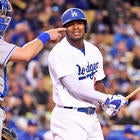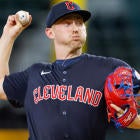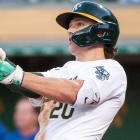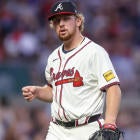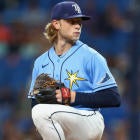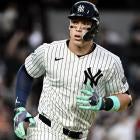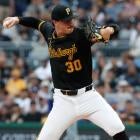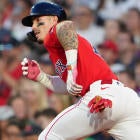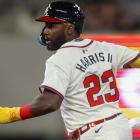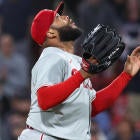We haven't taken the opportunity to reach out to the people and answer their questions directly so far this season, so I figured now was as good a time as any to do so. It's mailbag time!
@CTowersCBS yasiel pUiGH
— therealmikelife (@TheRealMikeLife) May 18, 2016
I was quite high on Yasiel Puig having a bounceback season, even naming him as a player who had a chance to break into the ranks of the elite and challenge for the top spot overall by the end of the season. Things haven't quite gone according to plan, but I'm not ready to totally give up on the upside he has shown in the majors. We're still talking about a player who hit .305/.386/.502 in 2013 and 2014, and has the skills to be a true five-category contributor.
He isn't that right now, and there really aren't many reasons to be optimistic about the way he is playing; Puig has hit a league-high 13 infield flyballs, nine more than he has homers. His hard-hit rate is just 31.3 percent, and his line drive rate is down to a career-low 14.3 percent. He is swinging and missing at 16.1 percent of pitches thrown his way, and his plate discipline has collapsed. Puig really isn't doing much well right now, but I still believe in the talent enough to make a buy-low offer for him, and I'm certainly not dropping him.
I am, however, benching him for someone like Marcell Ozuna at this point.
@CTowersCBS when would be a good time to sell high on Vince Velasquez?
— Matthew Rayan (@MattMRayan) May 18, 2016
I'm not sure you should necessarily sell high on Vince Velasquez; he's not, like, Taylor Jungmann, or something. This guy was a top-100 prospect before last season, and struck out 28.9 percent of batters he faced in the minors, so this isn't coming out of nowhere. You can't fake 98 MPH.
However, if you were going to sell Velasquez, there is no better time than right now. As good as he is, he probably isn't mid-2.00's ERA good, which probably means his value has nowhere to go but down. You also have to keep in mind that an innings limit is likely in his future, since he threw just 88 2/3 innings last season and has never thrown more than 124 2/3 in a full season.
If you buy that Velasquez is pitching a bit over his head, the only answer to "When should I sell high?" is "As soon as possible." That doesn't mean you trade him for nothing, of course. But putting out trade offers for a slumping star hitter like Giancarlo Stanton is a good idea.
@CTowersCBS have you looked into JV's slider? 87-88mph looks Warthen-like. really effective lately. pitching like a CY today.
— matt williams (@Mattyshack) May 18, 2016
If you don't know what it means to say a slider looks "Warthen-like," read this piece on Steven Matz. Mets pitching coach Dan Warthen teaches his pitchers to throw a harder slider with less vertical movement than the typical slider, and it has been especially effective for their pitchers.
Verlander's slider hasn't been thrown noticeably harder this season, however there is a clear up-tick over his last few starts, beginning with March 3 against the Indians, when he averaged 86.2 MPH with the pitch -- it had hovered between 83 and 85 for most of his first five starts. Verlander struggled in that start against the Indians, giving up seven runs, but still sits at a 3.49 ERA in the month of May overall, with 29 strikeouts in 28 2/3 innings of work.
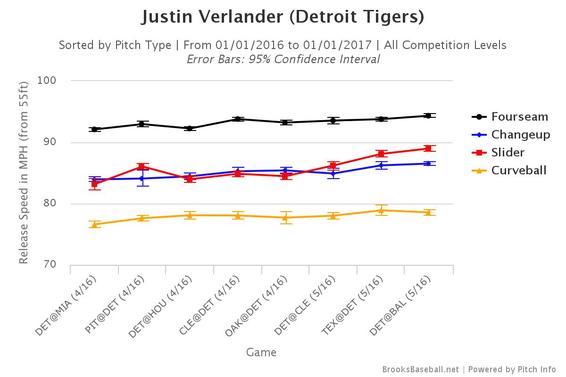
The slider probably isn't the reason for this turnaround, though he does have a solid 16.9 percent whiff rate with the pitch in May. Verlander's velocity has trended up as the season has gone on, but his overall results have been better than his 4.58 ERA might suggest -- he has more than a strikeout per inning overall, he has quality starts in seven of nine trips to the mound, and generally looks a lot more like a mid-3.00's ERA pitcher than his record suggests.
@AdamAizer I don't get it. His numbers say he should be way better than a 6.5era. highest K rate, swstr%, LD% normal. @CTowersCBS
— Ashton Gilmore (@AshtonGGilmore) May 18, 2016
The peripherals for Michael Pineda remain decent, with an xFIP of 3.62, nearly half his actual ERA of 6.90. However, he also dramatically underperformed his defense-independent pitching stats last season, so this is a recurring them for Pineda. He doesn't have much trouble racking up big strikeout numbers, and his control is fine, but Pineda tends to get hit really hard when he does get hit; opposing batters sport a 92.0 MPH average batted-ball velocity against Pineda, the fifth-highest mark among pitchers with at least 100 batted balls tracked by BaseballSavant.com.
That might explain Pineda's issues with homers. He's also struggled with runners on base, allowing an OPS north of .900 in those situations since the start of last season. That's a bad combination for a pitcher with issues keeping the ball in the park. I'm not ready to give up on Pineda, but I do have to wonder why we're all collectively higher on him than someone like Rubby De La Rosa, who has better stuff and is getting better results right now.
@CTowersCBS Fielder and Castellanos
— Justin Cote (@JustinSeeeee) May 18, 2016
Nick Castellanos' turnaround started last season, when he hit .269/.322/.478 in the second half of the season, with nine homers in 69 games. Castellanos' groundball rate dropped from 38.7 percent in the first half last season to 32.9 in the second half, and that trend has only continued this season; it's all the way down to 27.1 percent to open the seas0n. Castellanos is kind of mimmicking teammate J.D. Martinez's breakout by becoming a hugely flyball-heavy hitter -- ironically, Martinez currently sports his highest groundball rate since 2013, before he joined the Tigers.
Castellanos probably doesn't have Martinez's raw power, so don't expect him to start flirting with 40 homers all of a sudden. However, he has clearly improved his swing, and the results are impressive. No, he isn't a .350 hitter, either. But he might be able to hit .280 with 20-25 homers with this new approach; a breakout at 24 isn't exactly unprecedented.
@CTowersCBS What do we do with Prince Fielder?
— James Wilson (@ochurricane) May 18, 2016
.193/.259/.283... Why, this is what we expected from Prince Fielder last season! His strikeout rate is way up and his hard-hit rate is down to 25.4 percent, two signs that Fielder has taken a massive step back. At 32, and with a major surgery in his recent history, it isn't crazy to think Fielder might have just regressed this badly, and I wouldn't bet on him finishing as a top-12 first baseman from this point on.
That makes him a pretty fringe-y option, one you almost have to start thinking about dropping if he doesn't start showing signs of life; a .491 OPS in the month of May certainly doesn't qualify.
@CTowersCBS how's trading Herrera & C. Rodon for Keuchel & Heyward sound?
— Joe Willhoff (@mrbuff90210) May 18, 2016
This seems like a perfect opportunity to sell-high on Odubel Herrera, whose apparent breakout remains maybe the most confounding thing about the early season. Herrera walked in 5.2 percent of his plate appearances last season and 7.6 percent in the minors, but has already drawn 29 in 174 plate appearances to open the season. Compare that to last season, when he had 28 in 147 games, and it's just tough to make sense of this kind of breakout.
There is, of course, always the chance that Herrera has just improved, and you don't want to discount that. Still, Heyward is no slouch in the on-base department, and is likely to give you more homers and steals, so I'm not sure that is a downgrade. Add in what should be a clear upgrade at pitcher, and this is a win.
@CTowersCBS@CBSScottWhite Maikel Franco. Could he catch fire soon? He has been meh.
— Cecil Meyers (@cecil_meyers) May 18, 2016
I compared Maikel Franco favorably to Adrian Beltre before the season, citing his combination of power and plate discipline as the particular skillset that has powered Beltre to a Hall of Fame career, and I still stand by that comparison. However, Franco has taken a bit of a step back to open this season, with both his strikeout and walk rates in particular moving in the wrong direction.
Franco has become a more aggressive hitter so far this season, with a swing rate of 53.4 percent. The good news is, he isn't swinging all that much more often at pitches outside of the strike zone, so this should correct itself before long. He doesn't have much help in the lineup, so Franco might be pressing, but I would still believe in his skillset. The power is still there, with a .188 ISO not so far behind the .217 mark he posted last season to be concerned, and he should see more hits fall in when his .254 BABIP rises. I'm not giving up on Franco.
@CTowersCBS#FantasyMailbag cargo/rondon for revere/span/joe Ross?Categories league.My team lacked a sb threat besides Cain. Gave up first 2
— BC (@Brentc1629) May 18, 2016
As a general rule, I don't tend to value closers much in trade, though it is hard to move Rondon, who has been one of the best in baseball since the start of the 2014 season. But save opportunities have been a bit hard to come by with the Cubs sporting a historic run differential, and Joe Maddon isn't the kind of manager who is just going to save his closer for situations where he has a three-run lead in the ninth, which makes it tough for Rondon to get to that elite 40-save territory.
Still, relative to where they stand among their positional peers, you are giving up the two best players in the deal, which is tough. If you needed stolen bases specifically, Span and Revere should prove very helpful in that one category, but I don't love trading Gonzalez at the nadir of his value. Remember how good he was once he got hot last season?
@CTowersCBS drop Nicasio for a SP prospect stash?
— Micah (@frshmx2) May 18, 2016
If you drafted Juan Nicasio, you did it for roughly the same reason you would grab a starting pitcher prospect: the hope that he might be enough of a breakout candidate to provide surplus value based on your acquisition cost. With a mid-4.00's ERA and less than 5 1/3 innings per start, Nicasio hasn't given much value so far.
And it's not clear whether we should expect much more from the converted reliever. His strikeout rate is nice, but he has been predictably unable to go deep into games, and his peripherals don't exactly scream "Breakout." He has a 4.20 FIP and 3.92 xFIP, mostly thanks to his middling control and groundball rate, two things we shouldn't exactly expect him to improve on.
Nicasio was a nice spring story, and it was fun to believe that Ray Searage could work his magic. However, he's starting to look like just another league average pitcher, which makes waiting on his upside a lot less enticing. If Tyler Glasnow is available, don't hesitate to drop Nicasio for him, but I would even consider taking a flier on less-heralded prospects like Blake Snell, or Jameson Taillon, who are both tearing up the high minors. Even the likes of Julio Urias or Lucas Giolito, who seem like longer shots to make an impact in the majors, are probably worth betting on over Nicasio, who looks eminently replaceable right now.













